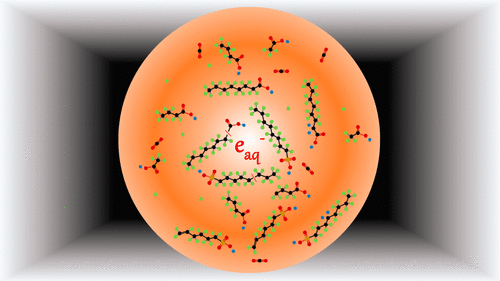当前位置:
X-MOL 学术
›
Environ. Sci. Technol.
›
论文详情
Our official English website, www.x-mol.net, welcomes your
feedback! (Note: you will need to create a separate account there.)
Destruction of Per- and Polyfluoroalkyl Substances (PFAS) with Advanced Reduction Processes (ARPs): A Critical Review.
Environmental Science & Technology ( IF 10.8 ) Pub Date : 2020-03-23 , DOI: 10.1021/acs.est.9b05565 Junkui Cui 1 , Panpan Gao 1, 2 , Yang Deng 1
Environmental Science & Technology ( IF 10.8 ) Pub Date : 2020-03-23 , DOI: 10.1021/acs.est.9b05565 Junkui Cui 1 , Panpan Gao 1, 2 , Yang Deng 1
Affiliation

|
Advanced reduction processes (ARPs) have emerged as a promising method for destruction of persistent per- and polyfluoroalkyl substances (PFAS) in water due to the generation of short-lived and highly reductive hydrated electrons (eaq–). This study provides a critical review on the mechanisms and performance of reductive destruction of PFAS with eaq–. Unique properties of eaq– and its generation in different ARP systems, particularly UV/sulfite and UV/iodide, are overviewed. Different degradation mechanisms of PFAS chemicals, such as perfluorooctanoic acid (PFOA), perfluorooctanesulfonate (PFOS), and others (e.g., short chain perfluorocarboxylic acids (PFCAs) and perfluorosulfonic acids (PFSAs), per- and polyfluoro dicarboxylic acids, and fluorotelomer carboxylic acids), are reviewed, discussed, and compared. The degradation pathways of these PFAS chemicals rely heavily upon their head groups. For specific PFAS types, fluoroalkyl chain lengths may also affect their reductive degradation patterns. Degradation and defluorination efficiencies of PFAS are considerably influenced by solution chemistry parameters and operating factors, such as pH, dose of chemical solute (i.e., sulfite or iodide) for eaq– photoproduction, dissolved oxygen, humic acid, nitrate, and temperature. Furthermore, implications of the state-of-the-art knowledge on practical PFAS control actions in water industries are discussed and the priority research needs are identified.
中文翻译:

使用先进的还原工艺(ARPs)销毁全氟和多氟烷基物质(PFAS):关键评论。
先进还原过程(的ARP)已经成为用于在水中持久per-和多氟烷基的物质(PFAS)破坏的有前途的方法,因为短寿命和高度还原水合电子的产生(E水溶液- )。这项研究对用e aq –减少PFAS的破坏机理和性能进行了重要的综述。e aq的独特属性–概述了其在不同ARP系统中的生成,尤其是UV /亚硫酸盐和UV /碘化物。PFAS化学药品的不同降解机理,例如全氟辛酸(PFOA),全氟辛烷磺酸(PFOS)等(例如短链全氟羧酸(PFCA)和全氟磺酸(PFSA),全氟和多氟二羧酸以及氟调聚物羧酸) ),进行审查,讨论和比较。这些全氟辛烷磺酸化学品的降解途径在很大程度上取决于其头基。对于特定的PFAS类型,氟代烷基的链长也可能影响其还原降解模式。PFAS的降解和脱氟效率受溶液化学参数和操作因素(例如pH值,化学溶质的剂量,例如亚硫酸盐或碘化物)的影响很大。水溶液–光产生,溶解氧,腐殖酸,硝酸盐和温度。此外,还讨论了最新知识对水行业中实际PFAS控制措施的影响,并确定了优先研究需求。
更新日期:2020-03-24
中文翻译:

使用先进的还原工艺(ARPs)销毁全氟和多氟烷基物质(PFAS):关键评论。
先进还原过程(的ARP)已经成为用于在水中持久per-和多氟烷基的物质(PFAS)破坏的有前途的方法,因为短寿命和高度还原水合电子的产生(E水溶液- )。这项研究对用e aq –减少PFAS的破坏机理和性能进行了重要的综述。e aq的独特属性–概述了其在不同ARP系统中的生成,尤其是UV /亚硫酸盐和UV /碘化物。PFAS化学药品的不同降解机理,例如全氟辛酸(PFOA),全氟辛烷磺酸(PFOS)等(例如短链全氟羧酸(PFCA)和全氟磺酸(PFSA),全氟和多氟二羧酸以及氟调聚物羧酸) ),进行审查,讨论和比较。这些全氟辛烷磺酸化学品的降解途径在很大程度上取决于其头基。对于特定的PFAS类型,氟代烷基的链长也可能影响其还原降解模式。PFAS的降解和脱氟效率受溶液化学参数和操作因素(例如pH值,化学溶质的剂量,例如亚硫酸盐或碘化物)的影响很大。水溶液–光产生,溶解氧,腐殖酸,硝酸盐和温度。此外,还讨论了最新知识对水行业中实际PFAS控制措施的影响,并确定了优先研究需求。











































 京公网安备 11010802027423号
京公网安备 11010802027423号